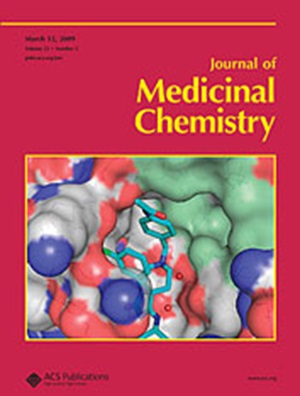Tumor Microenvironment-Responsive Lipid Nanoparticle for Blocking Mitosis and Reducing Drug Resistance in NSCLC
IF 6.8
1区 医学
Q1 CHEMISTRY, MEDICINAL
引用次数: 0
Abstract
Blocking mitosis is a promising strategy to induce tumor cell death. However, AMPK- and PFKFB3-mediated glycolysis can maintain ATP supply and help tumor cells overcome antimitotic drugs. Inhibiting glycolysis provides an opportunity to decrease the resistance of tumor cells to antimitotic drugs. Meanwhile, increased glutathione (GSH) expression in cancer cells due to glycolysis becomes a target for developing microenvironment-responsive drugs. Herein, a novel cationic lipid with disulfide bonds in hydrophobic tails was synthesized and used to prepare a GSH-triggered lipid nanoparticle named 2-DG@SLNP(siR) encapsulating both Plk1 siRNA and 2-deoxyglucose (2-DG) for blocking mitosis and reducing drug resistance of nonsmall cell lung cancer (NSCLC) cells in vivo. Experimental results showed that the NSCLC cell cycle was arrested at the G2/M phase by Plk1 siRNA and glycolysis was effectively inhibited by 2-DG, demonstrating the potential of 2-DG@SLNP(siR) as an efficient platform for blocking mitosis and reducing drug resistance of cancer cells.

肿瘤微环境响应性脂质纳米颗粒阻断非小细胞肺癌有丝分裂并降低耐药
阻断有丝分裂是一种很有前途的诱导肿瘤细胞死亡的策略。然而,AMPK-和pfkfb3介导的糖酵解可以维持ATP的供应,并帮助肿瘤细胞克服抗有丝分裂药物。抑制糖酵解为降低肿瘤细胞对抗有丝分裂药物的耐药性提供了机会。同时,糖酵解引起的肿瘤细胞中谷胱甘肽(GSH)表达增加成为开发微环境反应性药物的靶点。本文合成了一种在疏水尾部具有二硫键的新型阳离子脂质,并用于制备gsh触发的脂质纳米颗粒2-DG@SLNP(siR),该纳米颗粒包封Plk1 siRNA和2-脱氧葡萄糖(2-DG),用于阻断非小细胞肺癌(NSCLC)细胞的有丝分裂并降低其体内耐药性。实验结果表明,Plk1 siRNA可将NSCLC细胞周期阻滞在G2/M期,2-DG可有效抑制糖酵解,表明2-DG@SLNP(siR)可作为阻断有丝分裂和降低癌细胞耐药的有效平台。
本文章由计算机程序翻译,如有差异,请以英文原文为准。
求助全文
约1分钟内获得全文
求助全文
来源期刊

Journal of Medicinal Chemistry
医学-医药化学
CiteScore
4.00
自引率
11.00%
发文量
804
审稿时长
1.9 months
期刊介绍:
The Journal of Medicinal Chemistry is a prestigious biweekly peer-reviewed publication that focuses on the multifaceted field of medicinal chemistry. Since its inception in 1959 as the Journal of Medicinal and Pharmaceutical Chemistry, it has evolved to become a cornerstone in the dissemination of research findings related to the design, synthesis, and development of therapeutic agents.
The Journal of Medicinal Chemistry is recognized for its significant impact in the scientific community, as evidenced by its 2022 impact factor of 7.3. This metric reflects the journal's influence and the importance of its content in shaping the future of drug discovery and development. The journal serves as a vital resource for chemists, pharmacologists, and other researchers interested in the molecular mechanisms of drug action and the optimization of therapeutic compounds.
 求助内容:
求助内容: 应助结果提醒方式:
应助结果提醒方式:


